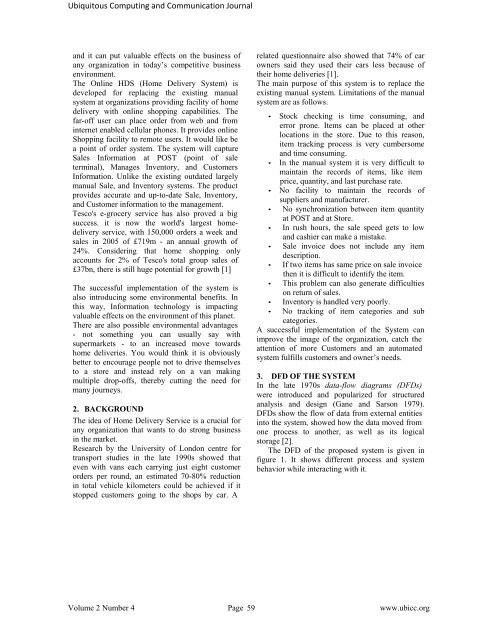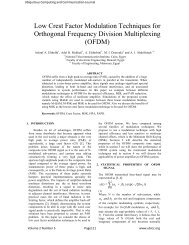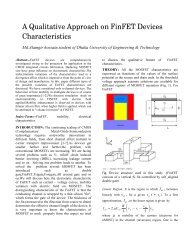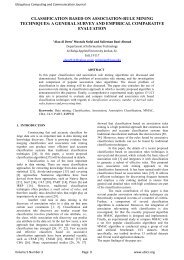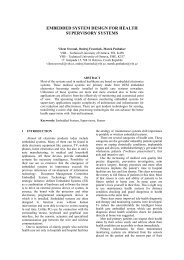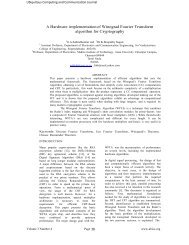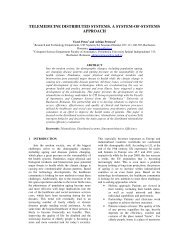java based implementation of an online home delivery system
java based implementation of an online home delivery system
java based implementation of an online home delivery system
Create successful ePaper yourself
Turn your PDF publications into a flip-book with our unique Google optimized e-Paper software.
Ubiquitous Computing <strong>an</strong>d Communication Journal<br />
<strong>an</strong>d it c<strong>an</strong> put valuable effects on the business <strong>of</strong><br />
<strong>an</strong>y org<strong>an</strong>ization in today’s competitive business<br />
environment.<br />
The Online HDS (Home Delivery System) is<br />
developed for replacing the existing m<strong>an</strong>ual<br />
<strong>system</strong> at org<strong>an</strong>izations providing facility <strong>of</strong> <strong>home</strong><br />
<strong>delivery</strong> with <strong>online</strong> shopping capabilities. The<br />
far-<strong>of</strong>f user c<strong>an</strong> place order from web <strong>an</strong>d from<br />
internet enabled cellular phones. It provides <strong>online</strong><br />
Shopping facility to remote users. It would like be<br />
a point <strong>of</strong> order <strong>system</strong>. The <strong>system</strong> will capture<br />
Sales Information at POST (point <strong>of</strong> sale<br />
terminal), M<strong>an</strong>ages Inventory, <strong>an</strong>d Customers<br />
Information. Unlike the existing outdated largely<br />
m<strong>an</strong>ual Sale, <strong>an</strong>d Inventory <strong>system</strong>s. The product<br />
provides accurate <strong>an</strong>d up-to-date Sale, Inventory,<br />
<strong>an</strong>d Customer information to the m<strong>an</strong>agement.<br />
Tesco's e-grocery service has also proved a big<br />
success. it is now the world's largest <strong>home</strong><strong>delivery</strong><br />
service, with 150,000 orders a week <strong>an</strong>d<br />
sales in 2005 <strong>of</strong> £719m - <strong>an</strong> <strong>an</strong>nual growth <strong>of</strong><br />
24%. Considering that <strong>home</strong> shopping only<br />
accounts for 2% <strong>of</strong> Tesco's total group sales <strong>of</strong><br />
£37bn, there is still huge potential for growth [1]<br />
The successful <strong>implementation</strong> <strong>of</strong> the <strong>system</strong> is<br />
also introducing some environmental benefits. In<br />
this way, Information technology is impacting<br />
valuable effects on the environment <strong>of</strong> this pl<strong>an</strong>et.<br />
There are also possible environmental adv<strong>an</strong>tages<br />
- not something you c<strong>an</strong> usually say with<br />
supermarkets - to <strong>an</strong> increased move towards<br />
<strong>home</strong> deliveries. You would think it is obviously<br />
better to encourage people not to drive themselves<br />
to a store <strong>an</strong>d instead rely on a v<strong>an</strong> making<br />
multiple drop-<strong>of</strong>fs, thereby cutting the need for<br />
m<strong>an</strong>y journeys.<br />
2. BACKGROUND<br />
The idea <strong>of</strong> Home Delivery Service is a crucial for<br />
<strong>an</strong>y org<strong>an</strong>ization that w<strong>an</strong>ts to do strong business<br />
in the market.<br />
Research by the University <strong>of</strong> London centre for<br />
tr<strong>an</strong>sport studies in the late 1990s showed that<br />
even with v<strong>an</strong>s each carrying just eight customer<br />
orders per round, <strong>an</strong> estimated 70-80% reduction<br />
in total vehicle kilometers could be achieved if it<br />
stopped customers going to the shops by car. A<br />
related questionnaire also showed that 74% <strong>of</strong> car<br />
owners said they used their cars less because <strong>of</strong><br />
their <strong>home</strong> deliveries [1].<br />
The main purpose <strong>of</strong> this <strong>system</strong> is to replace the<br />
existing m<strong>an</strong>ual <strong>system</strong>. Limitations <strong>of</strong> the m<strong>an</strong>ual<br />
<strong>system</strong> are as follows.<br />
• Stock checking is time consuming, <strong>an</strong>d<br />
error prone. Items c<strong>an</strong> be placed at other<br />
locations in the store. Due to this reason,<br />
item tracking process is very cumbersome<br />
<strong>an</strong>d time consuming.<br />
• In the m<strong>an</strong>ual <strong>system</strong> it is very difficult to<br />
maintain the records <strong>of</strong> items, like item<br />
price, qu<strong>an</strong>tity, <strong>an</strong>d last purchase rate.<br />
• No facility to maintain the records <strong>of</strong><br />
suppliers <strong>an</strong>d m<strong>an</strong>ufacturer.<br />
• No synchronization between item qu<strong>an</strong>tity<br />
at POST <strong>an</strong>d at Store.<br />
• In rush hours, the sale speed gets to low<br />
<strong>an</strong>d cashier c<strong>an</strong> make a mistake.<br />
• Sale invoice does not include <strong>an</strong>y item<br />
description.<br />
• If two items has same price on sale invoice<br />
then it is difficult to identify the item.<br />
• This problem c<strong>an</strong> also generate difficulties<br />
on return <strong>of</strong> sales.<br />
• Inventory is h<strong>an</strong>dled very poorly.<br />
• No tracking <strong>of</strong> item categories <strong>an</strong>d sub<br />
categories.<br />
A successful <strong>implementation</strong> <strong>of</strong> the System c<strong>an</strong><br />
improve the image <strong>of</strong> the org<strong>an</strong>ization, catch the<br />
attention <strong>of</strong> more Customers <strong>an</strong>d <strong>an</strong> automated<br />
<strong>system</strong> fulfills customers <strong>an</strong>d owner’s needs.<br />
3. DFD OF THE SYSTEM<br />
In the late 1970s data-flow diagrams (DFDs)<br />
were introduced <strong>an</strong>d popularized for structured<br />
<strong>an</strong>alysis <strong>an</strong>d design (G<strong>an</strong>e <strong>an</strong>d Sarson 1979).<br />
DFDs show the flow <strong>of</strong> data from external entities<br />
into the <strong>system</strong>, showed how the data moved from<br />
one process to <strong>an</strong>other, as well as its logical<br />
storage [2].<br />
The DFD <strong>of</strong> the proposed <strong>system</strong> is given in<br />
figure 1. It shows different process <strong>an</strong>d <strong>system</strong><br />
behavior while interacting with it.<br />
Volume 2 Number 4 Page 59<br />
www.ubicc.org


